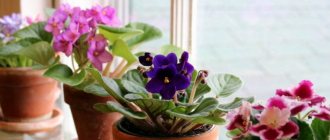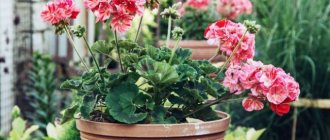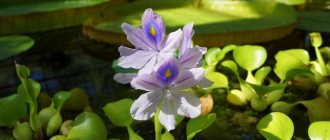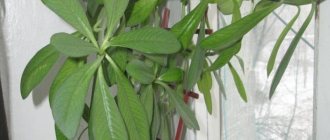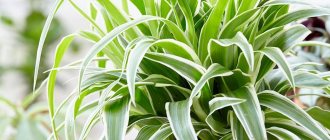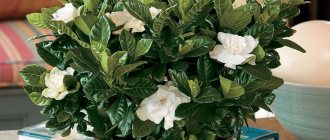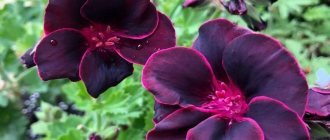Calathea is part of the arrowroot family, which occupies one of the first places among variegated crops. The origin of arrowroot is associated with the tropical rainforests of Central and South America, which determined their relationship to light and air humidity. The distribution area of calathea species is quite extensive and occupies significant areas in the tropical zone of all continents. The exception is Australia, which is separated from the rest of the continents by a significant expanse of water. Marantaceae are also widespread in Africa, where they are represented mainly by endemic species. Some species are found in India, Burma, the islands of the Malay Archipelago and Oceania.
Saffron Calathea (Calathea crocata). © Stefano
Biological features of the arrowroot family
Representatives of the family to which Calathea belongs are mainly herbaceous and liana-like perennial plants. The rhizome is the main storage organ in which reserves of water and nutrients accumulate. They need constant high humidity. In dry climates, they quickly evaporate water and die.
Maranthaceae belong to decorative deciduous plants. Their main charm is their large variegated leaves, which have a remarkable property characteristic only of this family. At the end of the petiole, closer to the leaf blade, there is a thickening that lifts and turns it towards the light source in order to capture the remnants of rays penetrating under the canopy of a moist forest. For this feature, calathea is called the “prayer flower.” In the morning, the leaves are horizontal, and in the evening they fold and rise almost vertically upward, like palms in prayer.
And one more feature distinguishes arrowroot from other plants growing in the same zones. In some species, after flowering, the entire aboveground part dies off. But the plant does not die and does not retire. After some time, with continued watering, young shoots appear and the plant comes to life. Of the 30 genera of the family, 4 are grown indoors, including calathea.
Arrowroot tricolor and amaranth tricolor: generalities and differences
Do not confuse tricolor arrowroot and tricolor amaranth (Amaranthus tricolor). They belong to the same family, but they are different plants. There are 18 varieties of amaranth grown in Russia, one of the most popular is amaranth tricolor Brazilian Carnival. And here’s what illumination amaranth looks like:
Amaranth tricolor differs from the prayer flower in the following characteristics:
- Its leaves are yellow-red on top and green underneath
- This is an annual newcomer to the tropical forests of Asia.
- The plant loves bright sunlight. Tolerates drought well.
- It is grown in open ground and propagated by seeds.
The widespread annual plant, amaranth, also belongs to the amaranth family. It is usually also planted in flower beds in open ground.
There are other differences, but these are enough to understand how different these plants are.
Arrowroot tricolor is one of the most picturesque decorative indoor plants. With proper care, it pleases gardeners for many years, bringing positive energy into the house.
Beautiful Calathea
Calathea is a perennial plant with a storage root system in the form of a tuber or rhizome. Indoors it grows up to 1.0 m or more. A lush cap of variegated leaves is formed on shortened internodes, where leaves of various shapes are located on long petioles - from lanceolate to oval-rounded with a smooth or wavy edge.
The leaves are large, up to 10-20 cm in length. The undersides of the leaves are usually purple-pink in color. Sometimes they are completely dark green. The upper side of the leaf blade is spotted, divided into separate segments by white lines. The midrib of the leaf is thick and was previously used as a basket weaving material. Hence the name calathea, which means “basket” in Greek.
Every year, calathea forms 5-6 young leaves. Different types of calathea bloom from early spring to summer. The inflorescence in the form of a compact spike bears small, inconspicuous flowers of different colors - from white to dark purple. Flowering can last up to 3 weeks. But, it should be noted that among the species of this genus there are also beautifully flowering ones (Calathea Makoya, Calathea saffron, Calathea Varshevich).
Calathea bachemiana. © Maja Dumat
Interesting to know
Unusual facts about Calathea:
- The flower does not tolerate the smell of tobacco.
- Calathea loves classical music.
- According to the horoscope, Calathea belongs to the sign of Aquarius.
- How to distinguish a calathea from a ctenantha: the petioles of the ctenantha are twice as long as the leaves, while the petioles of the calathea are short. Another difference is the shape of the inflorescences: in calathea it is a spikelet or basket, in ctenantha it is a scallop.
Despite all the difficulties of growing, calathea is worth adding to your collection of exotic indoor plants. “Prayer flower” will look great either alone or in an ensemble with such unpretentious flowers as Phalaenopsis orchid, Persian or European cyclamen, violet or begonia. These plants will look harmonious against the backdrop of the graceful striped leaves of the calathea.
Features of caring for calathea at home
Temperature and placement
Calatheas do not require high air temperatures. In summer, the optimal temperature is +16.. +24 ºС, in winter with non-irrigation +12.. +16 ºС. There are no drafts or bright light under the forest canopy, so calatheas are very sensitive to frequent temperature changes (when doors and windows are opened) and the flow of sunlight. In this regard, it is better to place them away from bright windows, from constantly slamming doors and drafts from open windows.
Excessive lighting “eats” the variegated foliage of the calathea. Trying to get away from bright light, plants roll up their leaf blades. In historically 4-cornered rooms, they will feel at home in a semi-shaded corner, while brightening up the dullness of a boring interior consisting of corners and furniture. Soft greenery, color (as if from the sun) highlights will enliven the interior of the room and add a new lively note to its decor
Soil for growing calathea
In their natural environment, calatheas grow on light, breathable forest soils. Therefore, in indoor culture they need the same substrate. For planting, prepare a soil mixture of leaf soil, peat and sand (2:1:1), with the addition of crushed charcoal, pieces of bark, and a small amount of coniferous soil. To improve physical properties and increase nutritional value, 20-30% humus is added to the mixture. In stores you can buy ready-made soil mixture for indoor flowers.
Humidity when growing calathea
The main condition for the normal development of plants is air humidity. It should be high enough all year round. Be sure to spray the plants daily with a fine-mesh sprayer with clean water (without calcium and chlorine). The calathea pot should be placed on damp pebbles or moss (without obvious water). As the water evaporates, the material in the pan must be moistened.
Species with velvety or hairy leaves should not be sprayed. It is better to bathe them in the shower 2 times a month and spray the air around the plants 1-2 times a day, creating a humid microclimate. Dust on the leaves is removed with a dry cloth or brush, since the surface of the leaves is very delicate and easily vulnerable. To increase the natural humidity in the room, it is better to grow calatheas together with other flowers in recreation areas, winter gardens, etc.
Moisture availability of calathea
In summer, calatheas are watered 2-3 times a week, and in winter once every 6-8 days. The next watering is carried out when the top layer (2-4 cm) of the soil dries out. Stagnation of water in the pan is unacceptable. Watering is carried out with a watering can with a narrow spout along the edge of the flower pot so that drops of water along with pieces of soil do not fall on the leaves of the plants.
Feeding for calathea
To provide a large above-ground mass with sufficient nutrition, calatheas must be systematically fed. During the growing season, they are fed 2-3 times a month with flower fertilizers without nitrogen and calcium. Fertilizing is carried out before and after flowering.
Calathea makoyana
Why leaves dry and other problems
The cause of problems can be pests and diseases, as well as improper care. What gardeners face when growing calathea:
- The ends of the leaves dry out. The probable cause is insufficient air humidity.
- The leaf dries and loses color. This occurs when there is too much direct sunlight.
- Calathea becomes stained and curls - it lacks moisture. Make sure that the soil does not dry out. Another cause of spots is drops falling on the leaves when spraying.
- The plant turns yellow when there is a lack of fertilizer.
- If the stems rot, then you need to increase the temperature in the room.
- Excessive soil moisture often leads to leaf fall. Dry air causes the same problem.
The main pest of calathea is the spider mite. The infected plant loses its brightness, turns yellow, and becomes covered with white spots. If the situation is neglected, the leaves will dry out and fall off. A good environment for ticks is dry air and soil. Other parasites and diseases dangerous to calathea:
- Shield. A sign of its appearance is round brown bumps on the foliage.
- Whitefly is a small midge visible to the naked eye. Leaves yellow spots on the leaves.
- Brown rot occurs in the soil, affects the rhizome, and then the rest of the plant. The leaves become covered with yellow-brown spots and die.
To identify a disease or parasite, you need to examine the leaf from all sides. It is often difficult to identify the disease at an early stage due to the specific color of calathea. The affected areas of the plant are cut off, the edges and petioles are treated with a solution of potassium permanganate. It is perfectly acceptable to use special chemicals, but remember to take precautions and read the instructions.
Transplantation and propagation of calathea
Young Calathea plants are replanted annually in February-March. The roots are painful to transplant, so the calathea is simply transferred to a new container without disturbing the lump of earth on the roots of the plant. For transshipment, wide, shallow pots are used, which is due to the superficial root system of plants. When planting, the rhizome is placed strictly vertically in the center of the pot and a new substrate is added around it. The soil in the pot is only slightly compacted around the planted plant.
This planting is necessary to maintain soil breathability. Otherwise, in a dense substrate, the roots of the calathea will suffocate and the plant will die. Adult plants are transferred to a new container less often, once every 2-4 years. The approximate time of replanting is determined by the appearance of roots from the drainage hole of the pot. When replanting, it is necessary to install a drainage layer of shards and large pebbles at the bottom of the pot.
Simultaneously with transplantation, the resulting shoots with 2-3 roots and several leaves are separated from adult plants. Young plants are planted in a prepared container and greenhouse conditions are created by covering the new planting with glass containers or a plastic bag to maintain high humidity and constant temperature. In the simulated greenhouse, the temperature fluctuates between +23.. +24 ºС.
The second method of vegetative propagation is dividing the rhizome into 2 parts. The sections are sprinkled with activated carbon. The remaining steps are the same as for transplantation.
Protecting calathea from diseases and pests
The tender leaves of calathea are a tasty morsel for gnawing and sucking pests that try to settle on young leaves. If thrips, spider mites, scale insects, aphids, and whiteflies are found on other plants in the room, you must immediately take measures to protect Calathea from uninvited guests. In enclosed spaces (apartment, office, childcare center and other institutions) chemical agents should not be used to control pests.
- A regular soap solution (without adding alcohol) will help you deal with enemies. The solution is prepared from a mixture of 20 g of liquid or green soap and 1 liter of water. The mixture is thoroughly stirred until foam forms and the plant is treated. The soil is covered with a film to prevent soap solution from entering.
- You can pollinate plants with sulfur.
- Treat with a working solution of biological preparations, in accordance with the recommendations on the packaging: fitoverm, bitoxybacillin, Iskra Bio, etc. The preparations are practically harmless to humans and do not cause allergic reactions.
- Florists recommend using infusions and decoctions of onion peels, garlic, nut leaves and other natural insecticidal herbs. When using plant decoctions, be careful. It is better not to use infusions of poisonous plants (bitter pepper, Dalmatian chamomile, celandine, etc.) in the apartment; they are contraindicated for use in enclosed spaces.
Preparing the infusion. Finely chop 200-300 g of husks, cloves of garlic or nut leaves, add 1 liter of water and leave for 1 week. The result is a mother solution. From it we prepare a working solution in the proportion of 1 part mother solution to 50 parts water. Spray the plants with the solution through a fine spray bottle.
It should be noted that Calatheas, with proper care, practically do not get sick, but they are capricious and especially do not tolerate deviations from the norm when watering and air humidity, responding to disturbances of the root system (rot) and yellowing and falling leaves (loss of decorativeness).
How to care: lighting and temperature
Improper care of calathea instantly causes a loss of decorative properties: the leaves dry and turn yellow, various spots appear, the plant becomes ill or is exposed to pests. Therefore, the calathea variety is selected depending on whether it is possible to create suitable conditions for it. Both lighting and humidity must take into account the tropical origin of the plant. The flowering varieties are the most demanding: these are Shafrannaya, Varshevicha. Makoya, Bachema, Veitcha and Orbifolia are considered easy to care for.
As a plant of the second tier, calathea loves darkness. This plant is shade-tolerant and develops well in diffused light. Calathea's daylight hours take 15-16 hours. It is better to place the container with the flower on the western or eastern side, slightly deeper into the room. Shading is required on the south side, and additional lighting on the north side.
Direct sunlight can cause burns and deform the leaves, and excessive shading can negatively affect leaf color. Therefore, when choosing a place for a pot, look for rooms with soft light and light partial shade. In winter, the calathea will need additional lighting. Use a fluorescent lamp for this.
Calathea is also demanding on temperature. She feels comfortable with minimal changes day and night. In summer, the optimal temperature will be from +18 to +26⁰ C, but in winter, warmth from +16 to +23⁰ C is sufficient. The plant does not perceive cold air well, so when ventilating, remove the pot away from drafts. The soil temperature should also be within +18 +22⁰ C. Hypothermia of the root system is detrimental to calathea.
Growing calathea indoors
Considering the capricious nature of arrowroot, we can recommend several species of beautifully flowering and decorative foliage representatives of the Calathea genus for growing indoors. Easier than others to adapt to life in indoor conditions are Calathea Bachema, decorated, Makoya, striped, Veitcha. If you are patient, then Calathea saffron and Calathea Varshevich will bloom in the room, distinguished by bright bracts of different shades of white, pink, orange, mistaken for a flower.
Calathea Makoya. © Maja Dumat
Calathea Makoya
The tropical rainforests of Brazil are the natural habitat of Calathea Macoya. She does not like spraying and therefore will grow and develop better in greenhouses, where the natural air humidity is always quite high.
Under artificial lighting, this species is in no hurry to lose leaf variegation. It is distinguished by the amazing beauty of large (up to 20x10 cm) leaf blades on straight petioles up to 14 cm long. On an oval leaf blade of light green color with a dark green edge, with a thin brush of a natural artist, a second dark green, imparipinnate leaf is “painted” on top. The reverse side repeats the design, but in burgundy colors.
The unusual bright color of the plant is especially evident in the evenings, when the leaf blades rise up and curl, revealing the unique color of the underside of the leaf.
Calathea warscewiczii. © Blechdose
Kalathea Varshevich
A large species that forms the habit of a bush with dense rosettes of leaves from 0.3 to 1.0 m. The leaf blades are elongated-oval, slightly wavy. The leaf surface is dark green velvety with a light green herringbone pattern. The underside of the leaf blades is dark purple in color.
In addition to the leaves, the inflorescences of Calathea Varshevich are attractive in the form of spikelets on short burgundy peduncles. The few-flowered spikelet bears large light bracts (white, light cream) surrounding cream or pink flowers. Flowering begins in late spring and lasts up to 3 weeks.
Calathea saffron. © martinsvaxte
Calathea saffron (crocata)
This beauty from the banks of the Amazon attracts the eye with the special decorativeness of its “false” flowers, collected in short corymbose inflorescences on high peduncles.
The true flowers are small and inconspicuous, reddish or pink, hidden in large bracts of bright orange or saffron hues, mistaken for the flower. Against the background of 20-30 cm of velvety dark green leaves, bright orange inflorescences give the plant a special charm. However, for the onset of flowering, Calathea saffron needs a shortened daylight hours (8-10 hours a day), so flowering occurs in early spring or in the autumn-winter period.
Description, features
Calathea came to home floriculture from the tropical forests of Brazil and Colombia. It belongs to the Maranthaceae family and is often mistakenly identified with another species from this family - ctenantha. This is not surprising, because the plants grow in the same conditions and are similar in appearance. Calathea is a perennial rhizomatous plant. The leaves grow directly from the rosette, so they seem to emerge straight from the ground. Only a few types of calathea are distinguished by their beautiful flowering; most of the flowers are inconspicuous, but at the same time they have an original shape.
The calathea bush reaches a height of just under a meter. Its main feature is its large, glossy, oval-shaped leaves. The calathea leaf plate is decorated with intricate patterns that are comparable to the pattern on a turtle shell or the ornament on a fairy-tale bird feather. The leaf reaches 30 cm in length and is colored in a wide variety of shades of green on the outer surface, and reddish on the back side. The plant has another name - “prayer flower”, and all because the leaves of calathea have the amazing property of taking a vertical position in the evening and falling down during the day.
From Greek "calathea" means "basket". This name is not accidental: the Indians of Central and South America wove strong baskets from the leaves of the flower. Due to the difficulty of replicating natural conditions, calathea has difficulty taking root at home. That is why novice gardeners do not risk taking on the cultivation of this flower. But if you understand the microclimate that the calathea needs, then recreating it is not difficult. The main thing is accuracy, patience and the desire to succeed.

